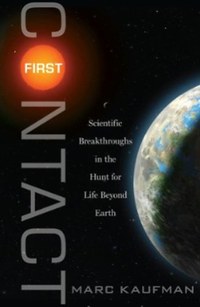Review: First Contactby Jeff Foust
|
| Kaufman devotes one chapter to a deceptively simple question: what is life? While it might seem straightforward, there is no canonical definition of life, and some argue that we simply don’t know enough to make such a definition. |
One interesting portion of the book looks at those people who still work in—or have been exiled to—the fringes of astrobiology even as the field gains wider acceptance. “[P]erhaps because of its urge for legitimacy, or because the discipline itself so often enters terra incognita, astrobiology has shown a consistent need to enforce a consensus,” casting aside those who differ, Kaufman writes. These people include Gil Levin, who argues the Labeled Release experiment on the Viking landers did, in fact, detect life on Mars; David McKay, who led the team that discovered what they still believe is evidence of life in Martian meteorite ALH 84001; and Richard Hoover, who claims to see similar evidence for life in other meteorites. All three get fair, if somewhat sympathetic, profiles in one chapter of the book; Kaufman goes so far to lament that the three, presenting in the same session of a conference, draw only a handful of people—nevermind that they’re speaking at a conference run by SPIE, an organization better known for optics and related technologies. (Since the book went to press, Hoover has gained notoriety for publishing a paper in the quixotic, controversial Journal of Cosmology about his asteroid life claims, an event that generated some media attention but was widely rebuffed as containing nothing new to support his claims.)
First Contact suggests that astrobiology has matured to the point where its practitioners now know how much they just don’t know about the subject. Kaufman devotes one chapter to a deceptively simple question: what is life? While it might seem straightforward, there is no canonical definition of life, and some argue that we simply don’t know enough to make such a definition. “Finding Extraterrestrial Life 2.0 would make it far more clear what Earthly Life 1.0 actually entails,” he writes, “and what is needed for something to be alive.” (That, though, requires that we would be able to positively identify said extraterrestrial life, leading one to wonder if astrobiologists might be reduced to a group of Potter Stewarts, knowing life when they see it.)
However one defines life, though, there’s yet been no broadly accepted evidence of it existing beyond Earth: the core purpose of astrobiology. Kaufman examines three possible options in the book’s final chapter: life only exists on Earth, life exists elsewhere but only Earth hosts complex life (the so-called “Rare Earth” hypothesis), and complex, even intelligent, life exists beyond Earth. He quickly dismisses the first option and, after some consideration, argues that the second option is unlikely as well: it’s less of a challenge for life to evolve than it is to come into being in the first place. It’s only a matter of time, he believes, before evidence of extraterrestrial life is found, either in our solar system or in the biosignatures of an extrasolar planet. If that does indeed happen, astrobiologists will never again have to worry about the legitimacy of their field.
